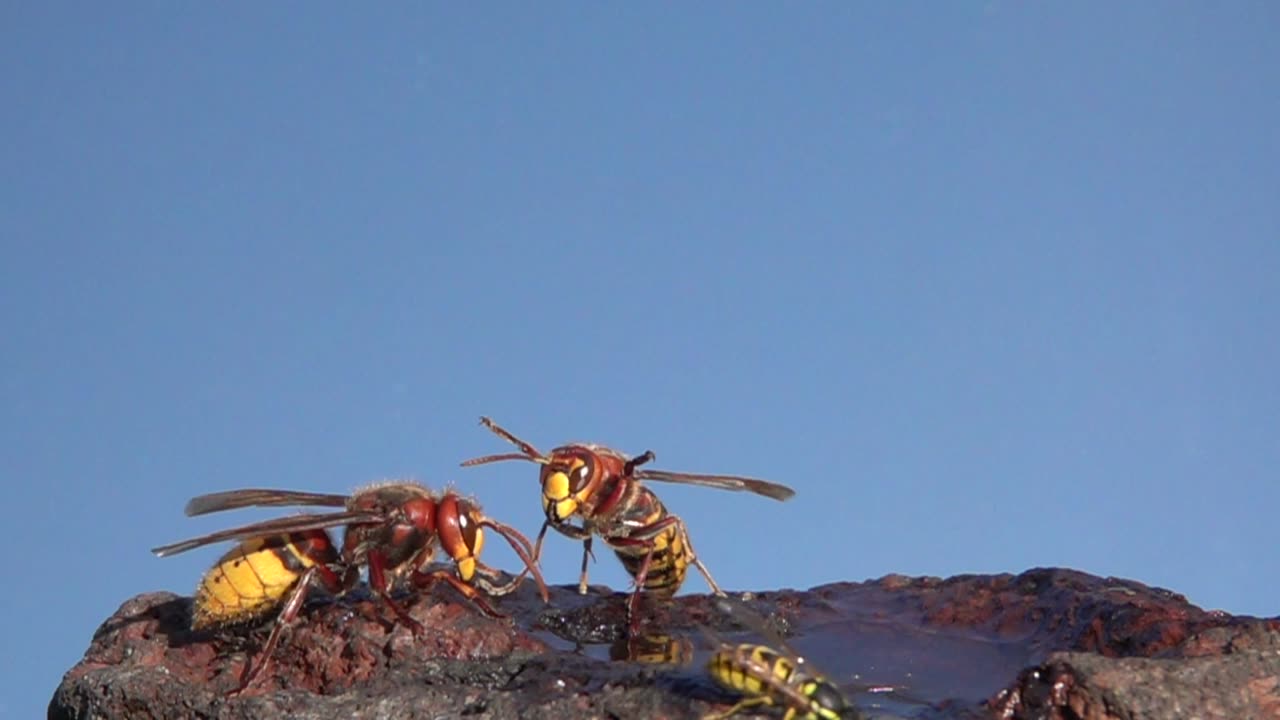Premium Only Content

Slow Motion Footage of Hornet Flight
Occurred on August 16, 2019 / Dohr, Germany
Info from Licensor: "Hornets and wasps, always lots of action at the feeding site.
Last summer I also spent time observing, photographing and filming social wasps in my garden in Dohr (in the Eifel region) in Rhineland-Palatinate, Germany. I spent hundreds of hours observing and arranging until the animals got used to me (and I got used to them) and then I managed to take some extraordinary pictures.
Honey bees, wasps, field wasps and hornets gather at a drinking trough filled with water or sugar water and enjoy drinking the energizing liquid. Especially in the fall, when the insect colonies are slowly approaching their annual end and the last workers have already hatched, various species gather here.
European hornets (Vespa crabro) and wasps such as the common wasp (Vespula vulgaris) or the German wasp (Vespula germanica) can often be observed at feeding sites such as fruit trees or sugary foods. Hornets, which are larger and stronger, are usually more dominant and quickly gain access to the best feeding sites thanks to their imposing appearance. Wasps, on the other hand, are usually more numerous and rely on speed and flexibility to meet their food requirements.
The flight maneuvers of these insects are fascinatingly precise. Hornets approach with calmer, almost leisurely movements, while wasps appear more nervous and hectic. Both species can hover to inspect food sources or perform quick evasive maneuvers when threatened. Conflicts over food are common: hornets drive away smaller wasps with threatening gestures or body jostling, while wasps occasionally build up pressure through mass or group displays.
Peaceful coexistence can also be observed at generous food sources. Hornets often occupy central areas of a food source, such as the center of an apple, while wasps remain at the edge. Things get exciting when hornets use their position to hunt and prey on smaller wasps - a behavior that emphasizes their role as efficient predators. There are also occasional small conflicts within groups of wasps, in which they communicate by bumping their bodies or raising their front legs.
These scenes are particularly noticeable on late summer days, when colonies are in need of high-energy food to prepare for the approaching fall. They provide a great opportunity to study the complex behavior of these fascinating insects from a safe distance."
-
 2:59:13
2:59:13
The Charlie Kirk Show
5 hours agoTrump vs. Zelensky Reaction + The Epstein Misfire + Charlie vs. Newsom | Schimel, Marlow, Baller | 2.28
171K61 -
 55:05
55:05
The Dan Bongino Show
7 hours agoAmerica Is Back In The World Stage, And We Love To See It (Ep. 2433) - 02/28/2025
825K1.56K -
 49:29
49:29
The Rubin Report
7 hours agoDetails About Joy Reid’s Weeping Farewell No One Noticed with Co-Host Megyn Kelly
99.5K138 -
 15:36
15:36
Tactical Advisor
5 hours agoMUST HAVE AR15 Upgrades for Under $100
53.7K3 -
 2:16:59
2:16:59
Benny Johnson
6 hours ago🚨Epstein Files COVERUP EXPOSED: FBI Sabotaging Trump, DELETING Evidence?! | Tapes 'MISSING'?!
154K366 -
 59:29
59:29
Steven Crowder
8 hours agoCrafting Crowder's Comedy Gold | Behind the Scenes
287K134 -
 2:06:44
2:06:44
Tim Pool
7 hours agoTHE END OF THE WEST, Will We Survive Without Christianity? | The Culture War with Tim Pool
143K92 -
 2:01:13
2:01:13
LFA TV
20 hours agoBODYCAM FOOTAGE OF TRAFFIC STOP! | LIVE FROM AMERICA 2.28.25 11AM
82.2K34 -
 1:23:10
1:23:10
The Big Mig™
9 hours agoGlobal Finance Forum From Bullion To Borders We Cover It All
57.7K3 -
 31:13
31:13
Tudor Dixon
7 hours agoThe Last Supper with Chris Tomlin | The Tudor Dixon Podcast
39.5K